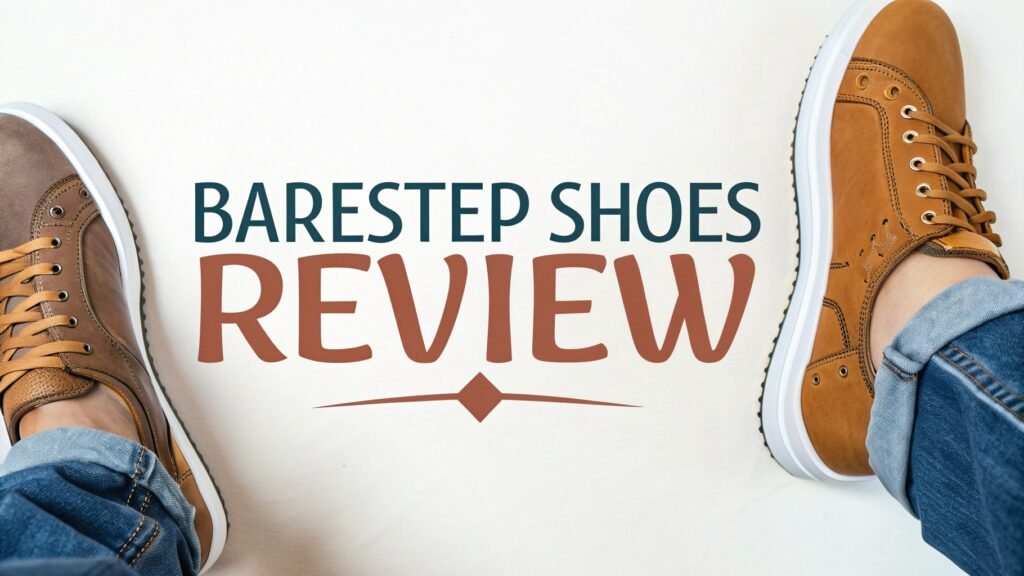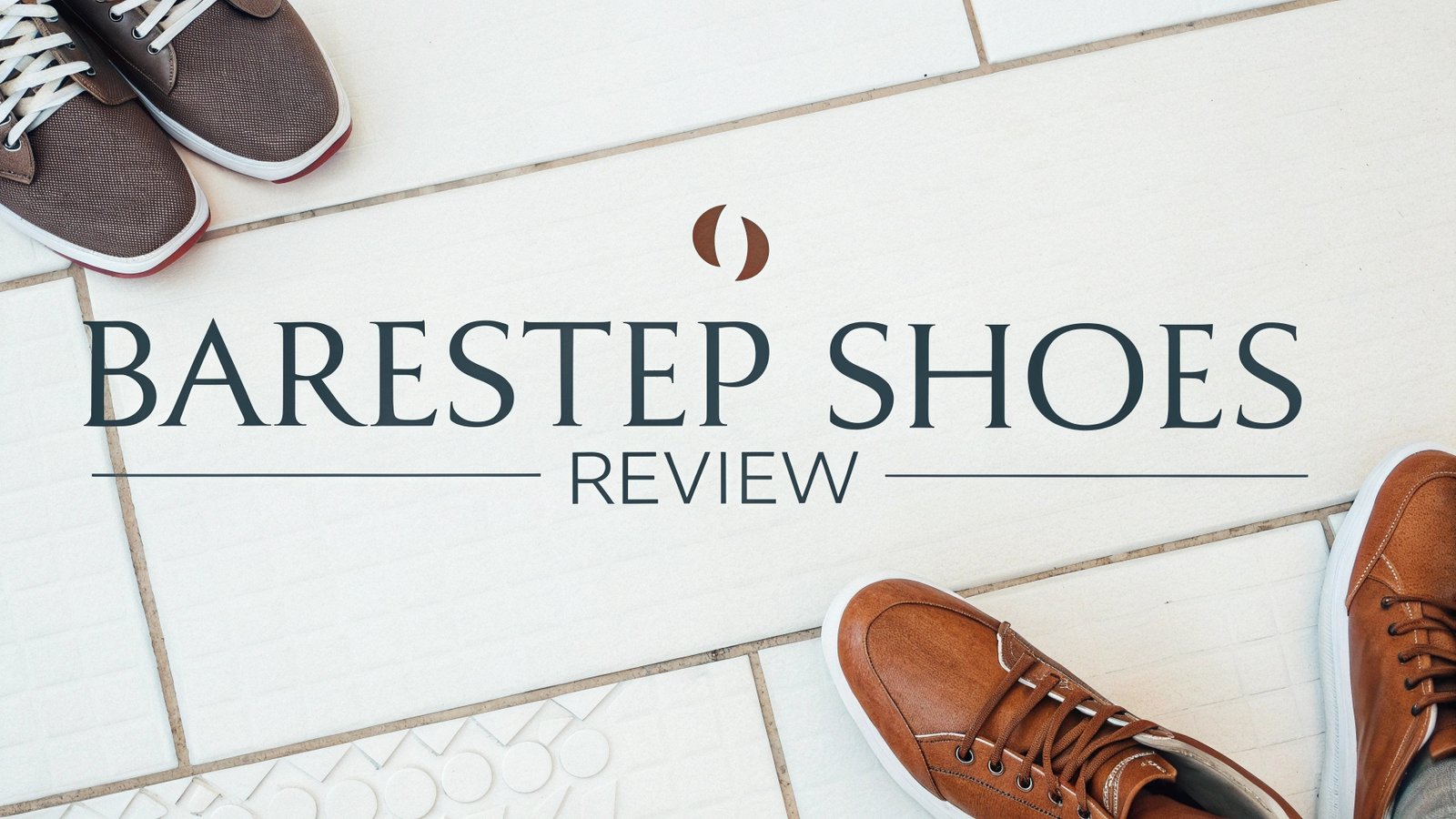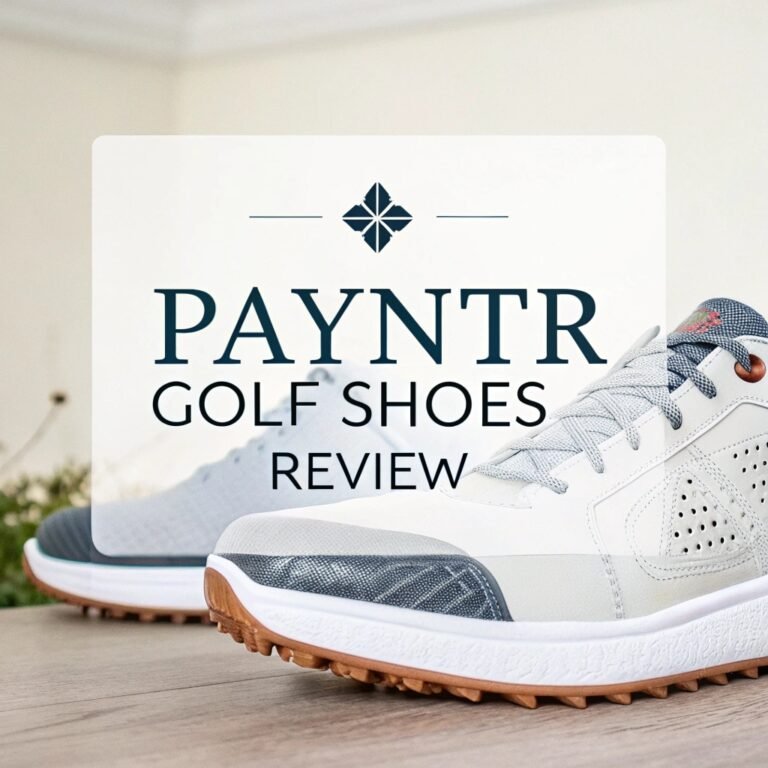Barestep Shoes Review: Are They Worth Your Money?
Have you ever thought about how your shoes might be hurting your feet? Regular shoes often squeeze toes together and block natural foot movement. This causes pain and makes your feet weak over time.
Barestep shoes offer a different way to walk. These shoes let your feet move as they were made to. They have wide toe boxes and thin, flexible soles that help your feet feel the ground.
Barestep has become popular with people looking for shoes that feel good and help their feet get stronger. The shoes claim to fix foot problems and give instant comfort. But do they really work? This post looks at Barestep shoes in detail. I tested them and gathered information from users and experts to give you the full story.

Key Takeaways:
- Barestep shoes feature a wide toe box that allows your toes to spread naturally, improving balance and reducing pain
- The zero-drop sole keeps your foot level from heel to toe, promoting better posture and natural walking motion
- These shoes are designed with ultra-flexible soles that bend with your foot, unlike stiff traditional shoes
- Barestep shoes claim to provide immediate relief from foot pain while also building strength for long-term foot health
- The shoes use breathable materials that keep feet cool and prevent sweating and odor
- Most models are lightweight, making them comfortable for all-day wear without fatigue
- Barestep offers several models including the Active, Active 2.0, Active 3.0, Peak, Everest, and Summit
- Prices range from $59.99 to $99.95 (on sale), with regular prices between $129.99 and $249.95
- The shoes come with a 30-day comfort guarantee with full refund if not satisfied
- Barestep shoes can help with common foot problems like plantar fasciitis, bunions, and neuropathy
- The company claims their shoes were developed with orthopedists to ensure proper foot function
- Proper sizing is important – some models run large while others fit more snugly
What Are Barestep Shoes?
Barestep shoes belong to the barefoot or minimalist shoe category. These shoes try to mimic the feeling of walking barefoot while still protecting your feet. The company makes several models of barefoot shoes for different activities and preferences.
The main idea behind Barestep shoes is simple but powerful. Traditional shoes often have thick cushioning, raised heels, and narrow toe boxes that change how your feet work. This can lead to foot weakness, pain, and problems throughout your body. Barestep shoes aim to let your feet move naturally.
All Barestep models share key features that make them true barefoot shoes. They have zero-drop soles, meaning the heel isn’t higher than the forefoot. This keeps your foot level with the ground, just like when barefoot. The wide toe box gives your toes space to spread out naturally. The thin, flexible soles let your feet bend and feel the ground beneath you.
The Science Behind Barefoot Shoes
The idea of barefoot shoes isn’t just a trend. It’s based on how our feet evolved to work. Human feet developed over thousands of years to walk without shoes. Our feet have 26 bones, 33 joints, and over 100 muscles, tendons, and ligaments. This complex structure works best when allowed to move freely.
Modern research supports many benefits of barefoot-style walking. Studies show that barefoot walking can strengthen foot muscles and improve balance. When your feet can feel the ground, your body gets better feedback about your position. This helps with balance and coordination.
Traditional shoes often have features that change how we walk. Raised heels shift our weight forward and can affect posture. Narrow toe boxes squeeze toes together, preventing natural toe spreading that helps with balance. Stiff soles stop feet from bending naturally and weaken foot muscles over time.
Barestep shoes address these problems with their design. The zero-drop sole keeps your body aligned properly from feet to head. The wide toe box lets toes spread naturally for better balance and comfort. The flexible sole allows your foot to bend and move as it should, strengthening foot muscles with every step.
Barestep Shoe Features and Benefits
Barestep shoes stand out with features designed to promote natural foot movement and comfort. Let’s look at the main features and how they benefit your feet.
Wide Toe Box
The wide toe box is perhaps the most noticeable feature of Barestep shoes. Unlike conventional shoes that squeeze toes together, Barestep gives your toes room to spread naturally. This space allows for better balance and can help prevent or reduce pain from bunions and hammertoes.
Zero-Drop Design
All Barestep shoes feature a zero-drop design, meaning the heel and forefoot are at the same height. Traditional shoes often have raised heels that tilt your body forward and change your posture.
The zero-drop design keeps your foot level with the ground, promoting proper alignment from feet to head. This natural position can reduce stress on knees and lower back. It also encourages a midfoot or forefoot strike when walking or running, which may reduce impact forces compared to heel striking.
Ultra-Flexible Soles
Barestep shoes have thin, flexible soles that bend with your foot. This flexibility allows your foot’s natural movement during walking and running. You can feel the ground beneath you, which helps with balance and proprioception (your awareness of your body’s position).
The flexible sole lets the many small muscles in your feet work as they should. Over time, this can strengthen foot muscles that may have weakened from years in stiff, supportive shoes. Stronger feet provide better natural support and may reduce dependence on artificial arch supports.
Breathable Materials
Barestep uses lightweight, breathable materials in their shoes. This keeps feet cool and dry even during active use. Good airflow reduces sweating and helps prevent odor and moisture-related problems like athlete’s foot.
The breathable upper materials conform to your foot shape for a comfortable fit without tight spots or rubbing. This reduces the chance of blisters and discomfort during long wear periods.
Lightweight Design
All Barestep models are lightweight, making them comfortable for all-day wear. Heavy shoes can cause fatigue and change how you walk. The light weight of Barestep shoes reduces energy expenditure during walking and feels more natural.
The lightweight design also makes the shoes more portable and convenient for travel. They won’t weigh down your luggage or feel burdensome during long days of sightseeing or activities.
Are Barestep Shoes Good for Foot Health?
Foot health benefits represent the main selling point for Barestep shoes. But do they actually help? The evidence suggests they can benefit many aspects of foot function.
Barefoot-style shoes like Barestep promote natural foot movement, which can strengthen foot muscles over time. When your foot muscles grow stronger, they provide better natural support for your arches and entire foot structure. This might reduce dependence on artificial supports and prevent weakness-related foot problems.
The wide toe box prevents toe compression that can lead to problems like bunions, hammertoes, and neuromas. When toes have space to spread naturally, they create a wider, more stable base for standing and walking. This improved toe function can enhance balance and reduce pain from existing toe deformities.
The zero-drop design helps maintain proper alignment from feet to head. When your heel isn’t artificially raised above your forefoot, your body can stand and move in its natural alignment. This may reduce stress on knees, hips, and lower back that can come from altered posture.
Barestep shoes improve proprioception – your awareness of your body’s position. The thin soles allow better feedback from the ground to your nervous system. This enhanced sensory input helps with balance and movement coordination, potentially reducing fall risk and improving athletic performance.
For specific foot conditions, Barestep shoes show promise:
- Plantar fasciitis: The flexible sole allows natural arch function, which may strengthen the foot and reduce strain on the plantar fascia. However, the transition period requires patience.
- Bunions: The wide toe box reduces pressure on the big toe joint, often providing immediate pain relief and possibly slowing bunion progression.
- Neuropathy: Increased ground feel may improve balance and sensation for those with reduced foot sensitivity, though results vary by individual.
- Flat feet: Barefoot-style shoes allow the foot to develop natural arch strength rather than relying on artificial support, potentially improving arch function over time.
While Barestep claims their shoes were developed with orthopedists, they don’t provide specific clinical studies on their products. The benefits align with general research on barefoot and minimalist footwear, but individual results will vary based on foot structure, activity level, and specific conditions.
Sizing and Fit Guide for Barestep Shoes
Getting the right size proves crucial for comfort and function with barefoot shoes. Barestep sizing varies between models, so follow these guidelines carefully.
Understanding Barestep Sizing
Barestep shoes follow standard numerical sizing, but how they fit differs by model:
- Active and Spark models run large. Size down one full size from your usual size.
- Active 2.0 fits true to size. Order your standard shoe size.
- Active 3.0 runs large, but Barestep has already adjusted for this. Order your usual size.
- Peak, Everest, and Summit models fit more snugly. If between sizes, size up one full size.
Remember that barefoot shoes should fit differently than conventional shoes. You want room for toe spreading but not excess movement that causes rubbing or instability.
Measuring Your Feet
For the most accurate sizing, measure your feet before ordering:
- Place a piece of paper against a wall
- Stand on it with your heel touching the wall
- Mark where your longest toe ends
- Measure the distance in centimeters
- Compare to Barestep’s size chart
Measure both feet, as most people have slight size differences. Use the larger foot measurement for sizing. Measure late in the day when feet are slightly larger from normal swelling.
Width Considerations
One advantage of Barestep shoes is their accommodating width in the toe box. This makes them suitable for many foot shapes, including wider feet that struggle with conventional shoes.
If you have particularly wide feet, consider going up a size in the snugger-fitting models like Peak and Everest. The Active line generally works well for various foot widths due to the very generous toe box.
Breaking In Period
Barestep shoes require minimal breaking in compared to stiff conventional shoes. The flexible materials generally conform to your feet quickly. However, your feet need time to adapt to the barefoot-style movement.
Any initial tightness in the upper material typically resolves within a few wears as the shoe adapts to your foot shape. Focus more on the gradual transition to barefoot movement than on “breaking in” the shoes themselves.
Barestep Shoes Pricing and Value
Barestep shoes range in price depending on the model and current promotions. Let’s examine their cost and value proposition.
Regular and Sale Pricing
Barestep regularly offers significant discounts from their listed regular prices:
- Barestep Active: $59.99 on sale (regular $129.99)
- Barestep Active 2.0: $74.99 on sale (regular $149.99)
- Barestep Active 3.0: $99.95 on sale (regular $249.95)
- Cold weather models: $84.95-$89.99 on sale (regular $199-$200)
The company frequently runs promotions, including buy-one-get-one-free offers that increase the value proposition. These sales appear common enough that most customers can purchase at discount prices rather than full retail.
Value Compared to Other Barefoot Brands
Compared to established barefoot shoe brands like Vivobarefoot (typically $150-$200), Xero Shoes ($80-$150), or Merrell Barefoot ($90-$140), Barestep’s sale prices position them as a more affordable option.
The quality and durability may not match premium barefoot brands, but the significantly lower price point makes Barestep an accessible entry point for those curious about barefoot shoes without wanting to make a major investment.
Durability Considerations
User experiences with Barestep durability vary. Some report their shoes lasting many months of regular wear, while others mention signs of wear appearing relatively quickly. The improved construction of the Active 2.0 and 3.0 models seems to offer better longevity than the original Active.
For the best value, consider how you’ll use the shoes. For occasional or light use, the basic Active model may provide sufficient durability at the lowest price. For daily wear or more intensive activities, the Active 2.0 or 3.0 likely offers better long-term value despite the higher initial cost.
Warranty and Return Policy
Barestep offers a 30-day comfort guarantee with a full refund if you’re not satisfied. This reduces the risk of trying their shoes, especially for first-time barefoot shoe users unsure if the style will work for them.
The company doesn’t prominently feature information about warranties beyond the 30-day return period. This suggests they don’t offer extended warranties against defects or premature wear, something to consider when evaluating long-term value.
Frequently Asked Questions
Are Barestep shoes good for plantar fasciitis?
Barestep shoes can help with plantar fasciitis by promoting natural foot movement and strengthening. The flexible sole allows your arch to work properly rather than being artificially supported. Many users report improvement over time, but the transition period may temporarily increase discomfort. Start with short wearing periods and increase gradually.
Can I wear Barestep shoes if I have flat feet?
Yes. Barefoot shoes like Barestep can actually benefit people with flat feet by allowing the foot to develop natural strength rather than relying on artificial arch support. The muscles that support your arch can grow stronger when allowed to work naturally. However, transition slowly and consider consulting a foot health professional for personalized advice.
How long do Barestep shoes last?
Durability varies based on use and model. Most users report several months of regular wear before significant signs of wear appear. The Active 2.0 and 3.0 models generally last longer than the original Active due to improved construction. For the longest lifespan, rotate between multiple pairs and use them primarily on less abrasive surfaces.
Are Barestep shoes good for running?
Barestep shoes can work well for running after a proper transition period. Start with very short distances and increase gradually over weeks or months. The Active 2.0 or 3.0 models provide better durability for running. Be prepared to adjust your running form, as barefoot-style shoes often lead to a midfoot or forefoot strike rather than heel striking.
Do barefoot shoes strengthen feet?
Yes. The natural movement allowed by barefoot shoes like Barestep activates and strengthens foot muscles that may be weak from years in conventional supportive shoes. This strengthening can improve arch function, balance, and overall foot health over time. Consistent wear combined with foot exercises provides the best results for foot strength.
Can I wear Barestep shoes all day?
Once you’ve transitioned properly, most people can comfortably wear Barestep shoes all day. Start with shorter periods and gradually increase as your feet adapt. The lightweight, flexible design prevents fatigue even with extended wear. The breathable materials keep feet comfortable throughout the day in most conditions.
Are Barestep shoes good for neuropathy?
Many people with neuropathy find barefoot shoes helpful because the increased ground feel improves balance and proprioception. The wide toe box prevents pressure points that can cause discomfort. However, results vary by individual, and those with severe loss of sensation should discuss barefoot shoes with their healthcare provider before trying them.
How do I clean Barestep shoes?
Clean Barestep shoes by hand washing with mild soap and warm water. Remove the insoles if possible and wash separately. Allow to air dry completely away from direct heat sources. Do not machine wash or dry as this may damage the materials and affect the shoe’s structure. Spot cleaning works well for minor dirt or stains.

Mia Smith is the founder of Shoe Storyteller, a blog that celebrates the art and stories behind shoes. With a passion for fashion and a flair for storytelling, Mia brings a unique perspective to the world of footwear.







